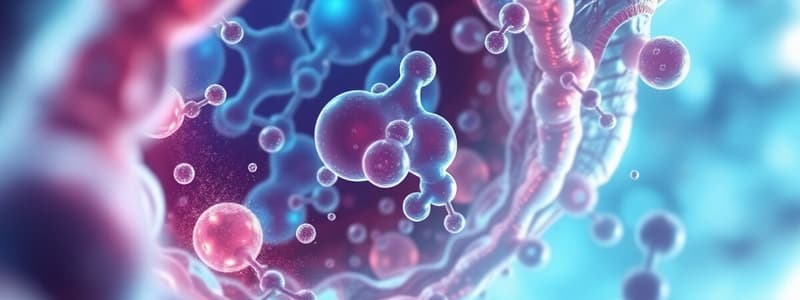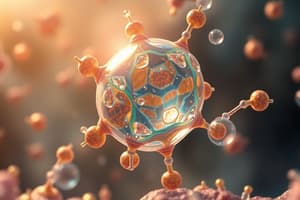Podcast
Questions and Answers
What is the smallest unit of chemical elements?
What is the smallest unit of chemical elements?
Atom
Which of the following elements make up 96% of living matter?
Which of the following elements make up 96% of living matter?
- Hydrogen (correct)
- Carbon (correct)
- Oxygen (correct)
- Sulfur, Calcium, Potassium, Phosphorus (correct)
- Nitrogen (correct)
Hydrophilic substances repel water.
Hydrophilic substances repel water.
False (B)
Pure water can dissociate into a __________ ion and a __________ ion.
Pure water can dissociate into a __________ ion and a __________ ion.
What is the smallest unit of chemical elements?
What is the smallest unit of chemical elements?
Which of the following elements make up 96% of living matter?
Which of the following elements make up 96% of living matter?
Ionic bonds involve the sharing of electrons between two atoms.
Ionic bonds involve the sharing of electrons between two atoms.
What type of bond results from the unequal sharing of electrons?
What type of bond results from the unequal sharing of electrons?
What is the composition of water?
What is the composition of water?
Match the terms related to water with their definitions:
Match the terms related to water with their definitions:
What is a substance that is dissolved in a solution called?
What is a substance that is dissolved in a solution called?
Solid water (ice) has stable hydrogen bonds.
Solid water (ice) has stable hydrogen bonds.
What is the pH level of human blood?
What is the pH level of human blood?
Which of the following compounds are carbon-based?
Which of the following compounds are carbon-based?
How many valence electrons does a carbon atom have?
How many valence electrons does a carbon atom have?
Acids increase the proton [H+] concentration in a solution while bases _____ this concentration.
Acids increase the proton [H+] concentration in a solution while bases _____ this concentration.
Study Notes
Structural Organization of Cells
- Atoms are the foundation of all matter, including cells.
- Molecules are formed by combinations of atoms.
- Cells are formed by combinations of molecules.
Cell Composition
- Water makes up 70-95% of a cell.
- Carbon-based molecules make up the remaining percentage.
- Essential Elements: 25 elements are essential for life.
- Major Elements: 96% of living matter is made of carbon (C), oxygen (O), nitrogen (N), and hydrogen (H).
- Minor Elements: Sulfur (S), calcium (Ca), potassium (K), and phosphorus (P) make up about 4%.
- Trace Elements: Examples include iron (Fe), iodine (I), zinc (Zn), and copper (Cu).
- Atoms: The smallest unit of a chemical element.
- Chemical Bonds: Enables atoms to combine and form molecules and compounds.
- Strong Bonds (Intramolecular):
- Covalent Bonds: Electrons are shared between two atoms.
- Non-polar Covalent Bonds: Electrons are shared equally.
- Polar Covalent Bonds: Electrons are shared unequally.
- Ionic Bonds: Electrons are transferred between two atoms.
- Covalent Bonds: Electrons are shared between two atoms.
- Weak Bonds (Intermolecular):
- Hydrogen Bonds: A hydrogen atom forms a covalent bond with another atom in the same molecule and a weaker bond (hydrogen bond) with an atom in another molecule.
- Strong Bonds (Intramolecular):
- Chemical Bonds: Enables atoms to combine and form molecules and compounds.
- Molecules: Two or more atoms combined.
- Compounds: Molecules made up of two or more elements in a fixed ratio, e.g., Sodium chloride (NaCl - table salt).
Molecular Structure and Chemical Properties of Water
- Composition: Made up of hydrogen (H) and oxygen (O).
- Structure: Two hydrogen atoms covalently bonded to one oxygen atom.
- Polar Covalent Bonds: Electrons are unequally shared.
- Oxygen: Attracts electrons, giving it a partial negative charge.
- Hydrogen: Has a partial positive charge (H+).
- Special Properties:
- Cohesion: Interactions between water molecules due to hydrogen bonds forming between H and O of adjacent water molecules.
- Each water molecule can form hydrogen bonds with up to four partners.
- Solvent: Water interacts with other molecules by forming hydrogen bonds.
- Example: NaCl (table salt): Na+ bonds with water's oxygen, and Cl- bonds with water's hydrogen.
- Solvent: A substance in which another substance dissolves.
- Solute: A dissolved substance.
- Solution: Mixture of solute and solvent.
- Cohesion: Interactions between water molecules due to hydrogen bonds forming between H and O of adjacent water molecules.
- Solid and Liquid Water:
- Solid water (ice): Hydrogen bonds are stable.
- Liquid water: Hydrogen bonds break and reform.
- Hydrophilic and Hydrophobic Substances:
- Hydrophilic Substances: Have an affinity for water due to polar covalent or ionic bonds that can form hydrogen bonds with water.
- Examples: NH3 (ammonia), NaCl (table salt), proteins with ionic or polar regions.
- Hydrophobic Substances: Repel water due to non-polar covalent bonds.
- Examples: Lipids (dominant bonds are C-C and C-H with equal sharing of electrons).
- Hydrophilic Substances: Have an affinity for water due to polar covalent or ionic bonds that can form hydrogen bonds with water.
Dissociation of Water Molecules and pH
- Dissociation: Water can dissociate into a hydrogen ion (H+) and a hydroxide ion (OH-).
- Pure water: The concentration of H+ ions is equal to the concentration of OH- ions.
- Biological Solutions: The relative proportion of H+ and OH- ions can vary.
- Acids: Increase the proton (H+) concentration of a solution.
- Example: Hydrochloric acid (HCl) dissociates in water, releasing H+ ions.
- Bases: Decrease the proton (H+) concentration of a solution.
- Example: Ammonia (NH3) reacts with water, removing H+ ions.
Buffers
- Importance: Chemical processes in cells are sensitive to pH changes.
- Buffers: Resist changes in pH of a solution.
- Function:
- Donate H+ when the solution is depleted of H+ (acidic environment).
- Donate OH- or accept H+ when there is an excess of H+ in the solution (basic environment).
- Function:
- Human Blood:
- pH: 7.4
- Buffered by: Carbonic acid (H2CO3) and bicarbonate (HCO3-).
- Importance: Maintaining blood pH between 7.37 and 7.43 creates an optimal environment for cellular enzyme activity and membrane integrity.
Carbon Atoms
- Building Blocks: Carbon atoms are the building blocks of biological molecules.
- Valence Electrons: Carbon atoms have 4 valence electrons, enabling them to form four covalent bonds.
Molecular Diversity of Carbon Compounds
- Carbon Chains: Form the skeleton of most organic molecules.
- Carbon can bond with other carbon atoms to form chains of various lengths.
- Carbon can also bond with other elements such as hydrogen (H), oxygen (O), nitrogen (N), sulfur (S), and phosphorus (P).
- Functional Groups: Groups of atoms with specific chemical properties that attach to carbon skeletons, contributing to the diverse properties of biological molecules.
- Macromolecules: Large complex polymers assembled from monomers.
- Carbohydrates: Sugars and starches composed of carbon, hydrogen, and oxygen.
- Lipids: Fats, oils, and steroids composed of carbon, hydrogen, and oxygen.
- Proteins: Chain of amino acids with diverse functions composed of carbon, hydrogen, oxygen, nitrogen, and sulfur.
- Nucleic Acids: DNA (deoxyribonucleic acid) and RNA (ribonucleic acid), which store and transmit genetic information.
Studying That Suits You
Use AI to generate personalized quizzes and flashcards to suit your learning preferences.
Related Documents
Description
Explore the fundamental concepts of cell structure and composition in this quiz. Learn about the roles of atoms, molecules, and essential elements that form the building blocks of life. Understand how these components interact to create the cellular environment necessary for life.




